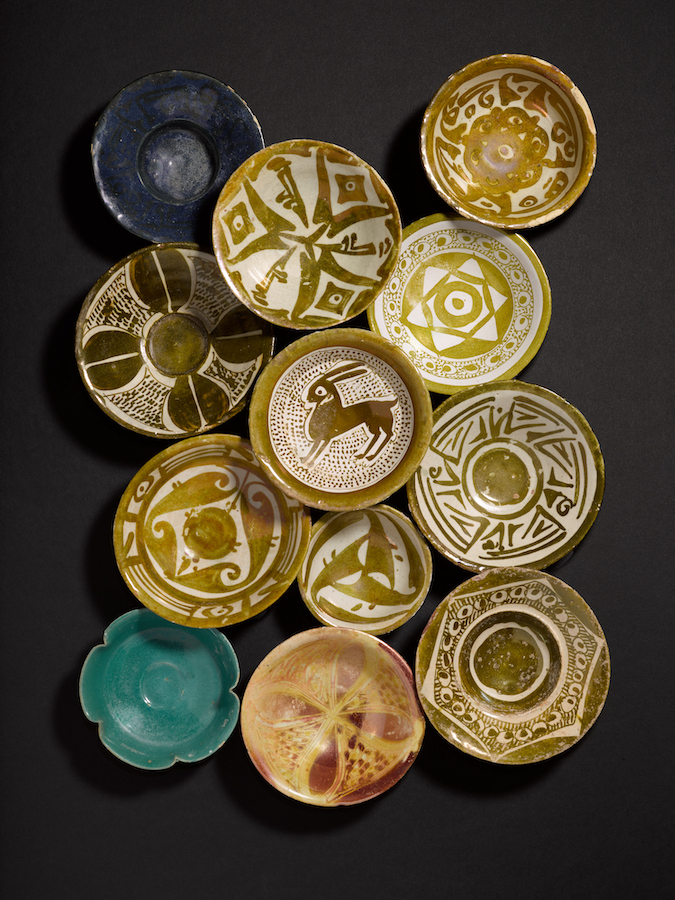DUBAI: Here are highlights from Sotheby’s upcoming autumn auctions of ancient and modern art from the Arab world.
Mohammed Al-Saleem

‘Untitled’
Last week, Sotheby’s Dubai hosted an exhibition of highlights from the auction house’s upcoming bi-annual Middle Eastern art week at its headquarters in London, which involves two auctions — “Arts of the Islamic World and India” and “Modern and Contemporary Middle East.” The exhibition included centuries-old Islamic artefacts from the Arab world, alongside canvases by some of the region’s most significant modern and contemporary artists. Among the latter was this untitled work by Al-Saleem, described by Sotheby’s as “one of Saudi Arabia’s foremost modern artists” who “has greatly contributed to the growth and evolution of art in the Kingdom.” The painter “belonged to a faction of cultural development in Saudi that sought a balance between the modernist and traditionalist aesthetics. Central to the artist’s oeuvre is a mediation between abstraction and figuration, in which he employs geometric forms to capture his surroundings,” the auction house states. This particular piece is expected to fetch up to £100,000 (roughly SAR500,000) at auction later this month.
Umayyad bronze buck

The highlight of the “Arts of the Islamic World and India” auction is this exceptionally rare bronze sculpture dating back to the 8th century CE, which is expected to fetch up to £3 million at auction. It is, Sotheby’s states, “indisputably one of the finest known animal sculptures from the Umayyad and early Abbasid period” and “one of only two known animal sculptures with a documentary inscription, recording the name of both its maker (Abdallah ibn Thabit) and patron (Ubaydallah ibn Jabir).” The is remarkable not just for its age and condition, but for its aesthetic merit. “Its cylindrical body gains movement by the sloping line that runs from the buck’s head to its deep rounded chest,” Sotheby’s notes. “This line shifts the visual weight slightly towards the rear, subtly emphasized by the angle of the animal’s well-articulated legs. It is as if he is tensing as he maintains his alertness…” A report compiled for Sotheby’s by Dr. Julian Raby concludes: “The buck … is a major addition to our understanding of figurative sculpture in the second century of the Hijra … It also happens to be a wondrous and sophisticated object in its own right.”
Leaf from Arabic translation of Dioscorides’ ‘De Materia Medica’

Between 50 and 70 CE, Greek physician Pedanius Dioscorides wrote his five-volume encyclopedia of herbal medicine, which remained the leading reference on the topic for more than 1,500 years and was used extensively across Europe and the Middle East, with the original text and illustrations being copied multiple times. This double-sided, illustrated leaf comes from an Arabic translation produced in Mesopotamia in the 13th century. “In the Arab context, the text was important not just for its pharmacological and medical information, but also for its role in developing the art of manuscript illumination,” Sotheby’s notes. This leaf, it continues, is an example of the School of Baghdad miniatures and “marks the bridge between the classically rooted Byzantine style of book illustration of the Late Antique period and the genesis of what would later be termed by Western scholars ‘Persian painting.’”
Ayman Baalbaki

‘7ay Jober’
The portrayal of war — whether through his expressionist portraits of fighters or paintings of ruined urban landscapes — has been a constant theme throughout the career of Baalbaki, one of Lebanon’s most popular contemporary artists. In this work, created in 2014, the artist shifted his focus from his homeland to the civil war raging in neighboring Syria, specifically the Jober district of Damascus. “Baalbaki’s works during this time mark an enduring commitment to communicating the plight of regional conflict,” Sotheby’s states. “Harnessing materiality and texture, Baalbaki presents a flurry of skillfully arranged, gestural strokes, harnessing emotion through mark-making.”
An illuminated Qur’an copied by Ya’qut Al-Musta’simi in 1275-6 CE

Sotheby’s describes Al-Musta’simi as “by far the most famous calligrapher in the history of Islamic art” whose “works have — for over 700 years — been among the most sought-after examples of the Islamic arts of the book.” This example of his work, written in naskh script, is “an exciting addition to a very small corpus of manuscripts reliably attributed to the calligrapher, and provides an insight into the workings of the royal scribal ateliers of Baghdad in the late 13th century.” According to the auction house, this is the only known Qur’an by Al-Musta’simi “not housed in a major library or museum.” It is expected to fetch between £600,000 to 800,000.
A group of 12 pottery dishes from Abbasid Iraq

This set of iridescent bowls is thought to have been created in the ninth or 10th century CE in Abbasid Iraq. It “perfectly showcases the decorative technique of lusterware — one of the most sophisticated, expensive and difficult of the period — by potters who sought to imitate the shine of gold,” Sotheby’s states. “These beautiful examples offer a rich array of designs, from animal motifs to abstract palmettes.”



































